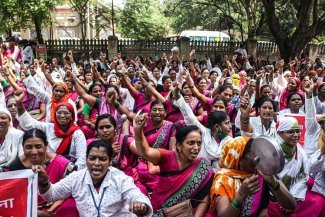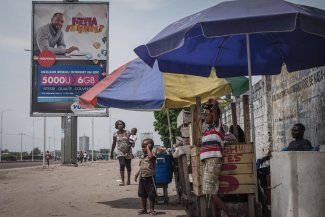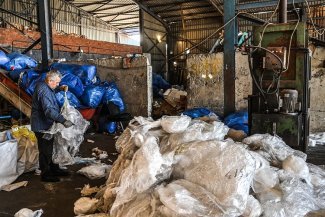Most of the 120 victims of the fire that broke out in a garment factory in Bangladesh on Saturday simply could not use the emergency exits.
Survivors said that when the fire alarms rang, many workers were prevented by the management from coming out of the factory. Managers claimed that the alarm was just for a drill.
Police and fire brigade officials found the bodies of the workers – mostly women - inside the multi-storied building of Tazreen Fashions, in the industrial zone of Ashulia, about 30 kilometres north of the capital Dhaka. Some workers died jumping from roofs and windows to escape the fire.
The death figure may still rise as the relatives of the missing workers are now looking for corpses.
According to the official report, issued by the Bangladeshi authorities on Monday, the death toll reached 112, while local media reported a figure of 124.
The head of the fire brigades, Major Mahbub, told AFP that many workers died of suffocation as the blaze started in the ground floor warehouse, trapping them upstairs.
They were working the night shift, and it took several hours to extinguish the flames.
Tazreen Fashions Ltd. is a subsidiary of the Tuba Group, a major Bangladeshi garment exporter whose clients also include Carrefour and IKEA. Its factories export garments to the U.S., Germany, France, Italy and the Netherlands, among other countries.
Tazreen opened in 2009 and employed about 1,700 people.
The owner of the factory, Delwar Hossain, told AFP that the plant made clothes also for C&A and Li Fung. However, he denied the allegation that the factory premises were unsafe. On its website, Tazreenclaims that there were 60 smoke detectors and over 200 fire extinguishers.
Eighty per cent of Bangladesh’s economy, worth $24 billion, depends on export of readymade garments, and the sector employs over three million workers, over 70 per cent of whom are poor women from rural areas.
However, labour unrest and occupational safety and health have long been a concern due to a low-paid, unsafe and unhealthy factory environment. Also, freedom of association and freedom of speech seem to be seriously limited, along with the right to strike.
Who is auditing?
Since there are not any effective government mechanisms to inspect the factories’ conditions, and due to pressure from foreign buyers like H&M, Walmart, Denim, Marks and Spencer, Carrefour, IKEA and others, Bangladeshi garment owners decided to meet compliances which are now supervised by the Bangladesh Garment Manufacturers and Exporters Association (BGMEA) through 40 monitoring teams.
BGMEA said that Tazreen Fashions is a member and that it was audited by a third party auditor.
However, according to Kalpona Akter, director of the Bangladesh Centre for Workers Solidarity, the factory did not meet the minimum requirements.
She told Equal Times that visiting the burnt factory herself, she found that none of the three stairs had direct links with outside and that workers had to come out from the ground floor crossing the room where yarn and fabrics were dumped.
“The first and foremost condition of the compliance, which is to keep entire corridors free, was not met. Besides, the fire has proved that the workers did not have any training in evacuating and fire extinguishing,” she added.
Al Jazeera revealed that Tazreen was given a “high risk” safety rating after a May 2011 audit conducted by an “ethical sourcing” assessor for Walmart.
And Walmart spokesman Kevin Gardner said that the company should have conducted another inspection by August 2012 and that it is not clear “if that inspection had been conducted or whether the factory was still making products for Walmart”.
BGMEA, which described the fire incident as ‘terrified’ and `unfortunate’, however sees the possibility of conspiracy.
It has already started an investigation to find the real causes of the fatal accident and announced it wants to compensate the families of the victims and provide a necessary treatment facility for the injured workers.
The spokesperson of Hong Kong multinational Li Fung said that they will compensate the families with $ 1,200 for each victim.
However, according to Kalpana Akter, the compensation should be considered as a “fatal accident”.
Bangladesh national labour law foresees that in this case the employer compensates the family with the whole salary for the entire working life of each dead worker.
Clean Clothes Campaign, an Amsterdam-based textile right group, says that at least 500 Bangladesh garment workers have died since 2006 in fire-related incidents.
Another fire broke out Monday in a second garment factory building outside Dhaka, but there were no reports of deaths. Only eight workers were injured due to heavy smoke.
Thousands of Bangladeshi workers took to the street on Monday to demand justice and inspections.
“We staged a huge demonstration demanding the arrest of the owner” said Mojibur Rahman Bhuiyan, General Secretary of the Bangladesh Mukto Sramik Federation (BMSF).
Protests turned violent with many throwing stones at factories and smashing vehicles. Hundreds of factories remained closed after the protests.








